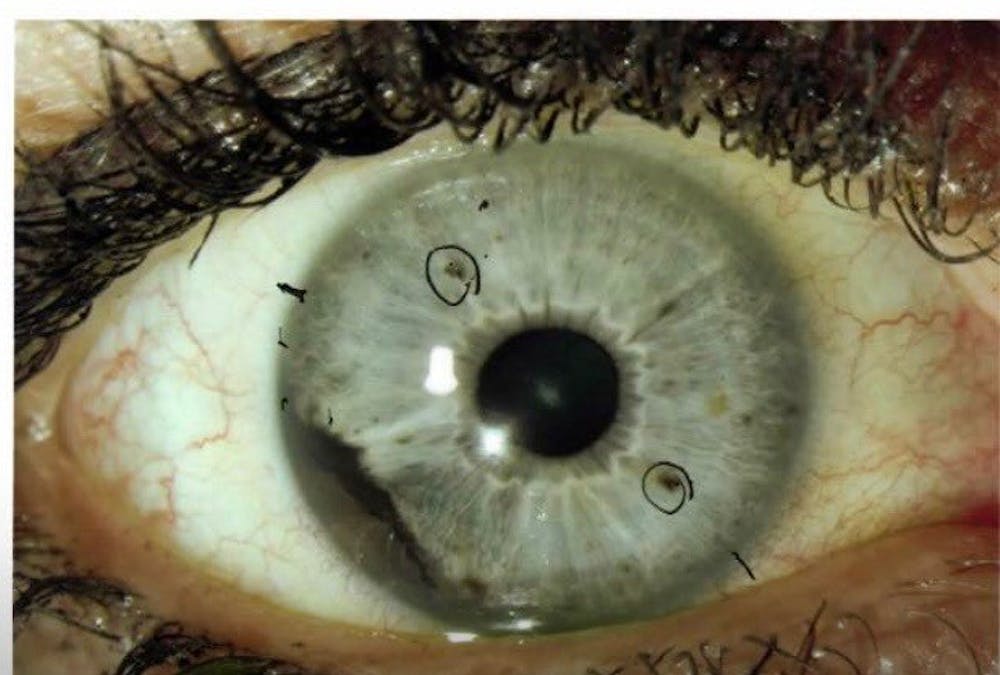Auburn University has committed to funding the first leg of a three-prong research study to determine potential causes of a surge of ocular melanoma diagnoses in Auburn alumni, faculty and employees.
The surge of cases — which has now risen to 27 confirmed cases even as ocular melanoma typically only presents in 5 in 1 million people — has garnered national attention.
After working over the last several months with a group of people who have been diagnosed with the disease, the University said Thursday that it would finance a geospatial analysis, according to the group of Auburn alumni pushing for the research.
"An independent consultant geospatial engineer is going to come in and ask a thousand questions to everybody and pray that people will send the information back," said Ashley McCrary, one of the women pushing for more research. "It's everything from where did you live, where did you go to school, where did you go to church, what water did you drink, what birth control did you take, did you use tanning beds, were you in a fraternity, did you play sports."
The second and third pieces of the research — a genetic analysis and an environmental analysis — will come next but could cost upward of $150,000. So far, the University has committed to paying the cost of the geospatial analysis. The cost, though unknown, is expected to be between $30,000 and $50,000.
"It's not a hard, fast number because it's really contingent upon how many people are involved in this part of the research," McCrary said.
University funding for the first part of the study will be matched in part by $22,000 raised so far by Auburn's ocular melanoma group.
"We have ... provided informational resources and updates to the campus community and beyond so those concerned have the latest information that is available," the University said in a statement. "In addition, we are engaging geospatial research experts to gather and analyze data that, among other things, will explore potential links to ocular melanoma in this area, none of which have been definitively found in any previous studies for this very rare cancer.
"This could help indicate the right and additional paths for future research in finding causes and treatments in the hope of developing a cure. The total cost of such research is yet to be determined."
The University's full statement is available below.
You can donate to the group's fundraiser by clicking here or by visiting the Community Foundation of East Alabama website.
McCrary and two others, Allyson Allred and Juleigh Green, were diagnosed during a similar time span. Allred's cancer has spread to her brain, and she has been undergoing treatments to slow its progress.
The three women were all friends when they attended Auburn at the same time. McCrary and Green were members of Alpha Gamma Delta and Allred was a Kappa Delta. The three friends lived near one another in the Quad dorm complex and later in the Hill, where sorority chapter dorms were during their time at Auburn.

Others who have also been diagnosed didn't have exactly parallel experiences. Some lived off campus, not all are women and some didn't pledge a sorority or a fraternity. So far, the group hasn't been able to identify a surefire smoking gun other than all of the confirmed cases being used for the study had attended Auburn or worked on campus.
The geospatial analysis will provide a three-dimensional map showing if any of the cases overlapped or intersected in a way that could provide additional information.
"That's important because it will drive the way the rest of the research is done," McCrary said. "It can also connect some of those dots that people have been asking about, who lived in the dorms, is that a factor or is it not. It's a huge part of the study and it was what we were looking to get started first."
Dr. Fred Kam, the director of the Auburn University Medical Clinic, and Dr. John Mason, Alabama's only ocular oncologist, have been spearheading meetings and pushing for the research.
"The fact that Auburn said they would pay for the geospatial analysis and didn't put a number to it is huge," she said, "because they're saying whatever it
The group will still need money for the second and third parts of the research.
"I appreciate the fact that Auburn is willing to help and congratulate them for stepping forward with funding," Mason said. "We will need additional funding from other sources and hope that others who want to make a difference will step forward so the additional studies can be done."
Mason said he was making this research his priority project.
"My opinion is that the research is the right thing to do," Mason said. "Whether we have money or not, we were not going to let this die down. This study is going to be done."
Kam and Mason will vet who is going to do the analysis, McCrary said.
There were initial concerns among the group that University funding for the study could taint whatever results are found, but McCrary said Kam and Mason's independent selection of the researchers will make the results credible.
"If it comes back inconclusive, they can't blame Auburn for that because it won't be Auburn who decides who does the research," McCrary said. "We're very excited about it. Elated is a good word. ... We feel like the Auburn Family again."

The cases have not yet been labeled a cancer cluster, but the Alabama Department of Public Health's state cancer registry has been verifying cases over the past several months. In May, The Plainsman reported the state had identified 20 confirmed cases.
The number of people who say they have been affected by the disease has continued to grow at a rate that appears to be grossly disproportional to Auburn's population.
Since then, the number of cases has risen by seven and McCrary, who has handled much of the initial information gathering, said she expects more cases to be confirmed in the coming weeks.
"There are names of people who have not been turned in," McCrary said, noting that some information needed to verify diagnosis or university attendance might have been kept before databases were made. "The University is going to look for it realizing that all of it isn't on a computer somewhere, it's on a floppy disk in a box in a warehouse somewhere. It's tricky to find it."
The prognosis for those affected by ocular melanoma is not promising.
"This cancer occurs in about 2,000 people in our country a year, so between five and six people out of 1 million people," Mason said at the time. "For ocular melanoma, the outlook is that there’s up to a 50 percent chance of
According to the American Cancer Society, when
Managing Editor Lily Jackson contributed reporting to this article.
Full University Statement:
Since we first became aware that several members of the Auburn family were diagnosed with ocular melanoma, we have had collaborative communications with experts on melanoma from around the nation, and we have worked closely with state public health officials. These communications are ongoing as the experts assist in determining what next steps should be taken in the best interests of the patients who are battling this cancer.
We have also provided informational resources and updates to the campus community and beyond so those concerned have the latest information that is available.
In addition, we are engaging geospatial research experts to gather and analyze data that, among other things, will explore potential links to ocular melanoma in this area, none of which have been definitively found in any previous studies for this very rare cancer. This could help indicate the right and additional paths for future research in finding causes and treatments in the hope of developing a cure. The total cost of such research is yet to be determined.
Do you like this story? The Plainsman doesn't accept money from tuition or student fees, and we don't charge a subscription fee. But you can donate to support The Plainsman.

Chip Brownlee, senior in journalism and political science, is the editor-in-chief of The Auburn Plainsman.





